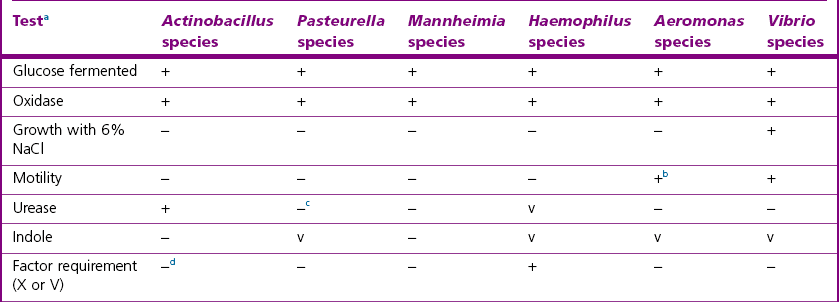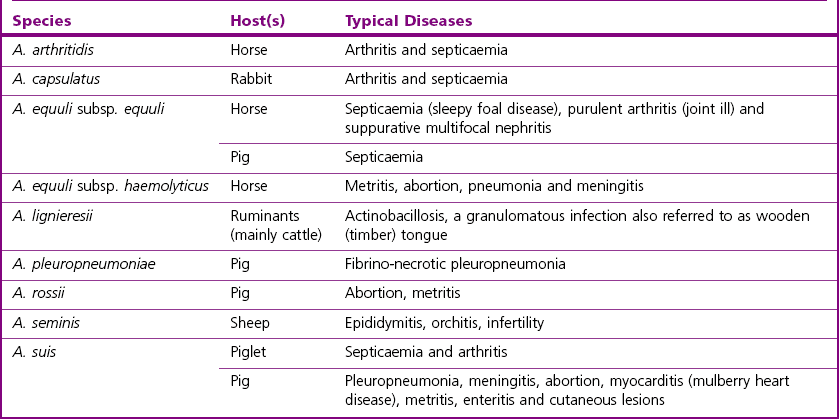Chapter 20 The genus Actinobacillus is within the Pasteurellaceae family, along with genera such as Pasteurella, Haemophilus, Histophilus and Mannheimia. The genus consists of many species that are commensals, some are pathogens of animals and more rarely humans. The Actinobacillus species are facultatively anaerobic fastidious Gram-negative, medium-sized rods (0.3–0.5 × 0.6–1.4 µm) that can produce coccal forms on routine solid media but longer forms in serum or sugar broths. Organisms may exhibit bipolar staining. Distinguishing features of the genus Actinobacillus from other Gram-negative rods can be found in Table 20.1. They are non-motile, non-spore-forming, non-acid-fast, indole-negative, usually oxidase-positive, reduce nitrates and produce beta-galactosidase. Actinobacillus species ferment carbohydrates within 24 hours without the production of gas. Most species grow on MacConkey agar as tiny lactose-fermenting colonies and produce urease. The reaction in the catalase test is variable. Actinobacillus species have a limited viability on solid media (seven to 10 days) and most have complex nutritional requirements. Growth is usually improved by a 5 to 10% CO2 atmosphere. Table 20.1 Presumptive identification of Actinobacillus and differentiation from similar Gram-negative genera of significance in veterinary medicine a+ = greater than or equal to 90% positive, − = less than or equal to 10% positive, v = variable, 11 to 89% positive b= except A. salmonicida which is non-motile c= except P. dagmatis, P. pneumotropica, P. aerogenes which are urease + d= except A. pleuropneumoniae biotype 1 which needs V factor Actinobacillus species are responsible for several distinct diseases of animals (Rycroft & Garside 2000). The major pathogenic Actinobacillus species in veterinary medicine are presented in Table 20.2. Actinobacilli are usually transmitted via the aerosol route or by close contact. The organisms can also gain entry through breaks in the skin. Actinobacillus pleuropneumoniae, A. suis, A. equuli and A. lignieresii are the most significant veterinary pathogens. Actinobacillus pleuropneumoniae is the aetiological agent of porcine pleuropneumonia, a highly contagious and often fatal disease. The organism can also colonize the upper respiratory tract of healthy pigs; no other natural host has been described to date. The disease can be peracute, acute or chronic. The peracute and acute forms are characterized by a necrotizing, fibrinohaemorrhagic pneumonia with pleurisy. Haemorrhage and severe congestion are seen in the lungs with serosanguinous exudate in the pulmonary cavity. This form has high morbidity and mortality. The chronic form of the disease can be seen in animals that survive infection, characteristic lung lesions include focal necrotic abscesses with layers of fibrous tissue that result in scarring of the lung. A review of the pathogenesis of A. pleuropneumoniae has been published by Bosse et al. (2002). Virulence factors such as adhesins, iron-acquisition factors, capsule, lipopolysaccharide (LPS), RTX (Repeat in Toxins) cytotoxins are all important with regard to colonization, avoidance of host clearance mechanisms and damage of host tissues. A summary of the principal virulence factors of A. pleuropneumoniae can be found in Table 20.3. Table 20.2 Main diseases caused by the major pathogenic Actinobacillus species in veterinary medicine Table 20.3 Main virulence factors of Actinobacillus pleuropneumoniae Actinobacillus lignieresii is the cause of actinobacillosis, wooden (timber) tongue, in cattle and less commonly in sheep. It is a sporadic, insidious, granulomatous infection. The organism appears to be a commensal of the upper respiratory tract of ruminants, causing disease after inoculation into mucous membranes during abrasion by rough feed. The lesions, numerous small abscesses, are usually limited to the soft tissues of the jaw, throat and tongue. Ulcers filled with pus can be seen on the tongue. The granulomatous lesions can also involve the skin and underlying tissues of the head, neck and limbs. Spread of infection by the lymphatics can occur occasionally to affect the lungs and other internal organs. The pyogranulomatous lesions formed by A. lignieresii resemble those of Actinomyces bovis (actinomycosis). Small, greyish-white granules (about 1 mm in diameter) are present in exudates from lesions of A. lignieresii. If these granules are crushed on a slide and stained, club colonies are seen consisting of club-like processes of calcium phosphate with the Gram-negative rods of A. lignieresii in the centre. Clinically, it can be difficult to distinguish a granulomatous lesion of A. lignieresii in the soft tissues of the jaw area from lumpy jaw (A. bovis). Table 20.4 summarizes the differential features of the two conditions. Virulence factors of A. lignieresii are still unknown. Table 20.4 Differentiation of Actinobacillus lignieresii and Actinomyces bovis infections in cattle
Actinobacillus species
Genus Characteristics

Pathogenesis and Pathogenicity

Virulence determinants
Functions
Apx toxins
RTX toxins
ApxI
Haemolytic and cytotoxic (strong), impairment of phagocytic function of macrophages and PMNs
ApxII
Haemolytic and cytotoxic (weak to moderate), impairment of phagocytic function of macrophages and PMNs
ApxIII
Cytotoxic only (strong), impairment of phagocytic function of macrophages and PMNs
ApxIV
Haemolytic (weak)*
Fimbriae of type 4
Mediate adherence to host cells
Proteases
May contribute to the pathogenesis of infection via cleavage of host proteins
Transferrin-binding proteins (TbpA and TbpB)
Iron uptake: High-affinity binding of porcine transferrin
FhuA
Iron uptake: Outer membrane receptor for ferric hydroxamate siderophores
HgbA
Iron uptake: A 104-kDa haemoglobin-binding protein
TonB-ExbB-ExbD
Three proteins transducing energy from the cytoplasmic membrane to the outer membrane receptor for iron transport into the periplasm
ABC-transport systems
Involved in uptake of iron across the cytoplasmic membrane
FhuBCD
Specific for ferric hydroxamate
afuABC
Periplasmic-binding-protein-dependent iron transport system, likely for unchelated Fe3+ across the cytoplasmic membrane
cbiKLMQO
High-affinity nickel uptake system
Capsule and/or LPS
Serum resistance
LPS
Activation of the alternative complement cascade, activation of alveolar and intravascular macrophages and production of pro-inflammatory cytokines
DnaK and Trigger factor
Stress response proteins essential for survival
Characteristics
Actinobacillus lignieresii
Actinomyces bovis
Specific disease
Bovine actinobacillosis or wonden (timber) tongue
Bovine actinomycosis or lumpy jaw
Granulomatous abscesses
Jaw, head, neck and limbs
Jaw region
Granules in exudates
Greyish-white, about 1 mm
Yellow ‘sulphur’ granules about 1 to 3 mm
Club colonies
+
+
Spread via lymphatics
+
−
Bone affected (osteomyelitis)
Uncommon
Common
Gram-stain reaction
Gram-negative rods
Gram-positive branching filaments or diphtheroidal forms
Atmospheric requirements
Growth in air (facultative anaerobe)
Anaerobic (H2 + CO2) ![]()
Stay updated, free articles. Join our Telegram channel

Full access? Get Clinical Tree


Actinobacillus species
Only gold members can continue reading. Log In or Register to continue
